V2015 Visual Studio How to Read Cpu Temperature
How to check your CPU temperature
Hither, we'll show you how to check your CPU temperature in Windows 10. If you're still using Windows seven, these steps will work equally well.
You've got two options at this stage: check your CPU temp with a dedicated monitoring program — the simpler pick — or figure information technology out on your own in your calculator'south UEFI/BIOS settings. Nosotros'll evidence you both means.
Check your CPU temperature with monitoring software
Intel and AMD, two popular CPU manufacturers, both offer CPU monitoring software for their products. For an all-purpose solution, you can effort Core Temp, a popular and free third-political party selection. Many people use it while stress-testing their CPU — a process in which you run your reckoner at full speed for a prolonged period of fourth dimension to evaluate its performance and check its reliability under loftier load and temperature. Here's how to use Core Temp on your computer:
-
Download Core Temp and install it. Note that unless y'all uncheck the corresponding box during installation, the program will as well install a desktop shortcut for a browser game called Goodgame Empire.
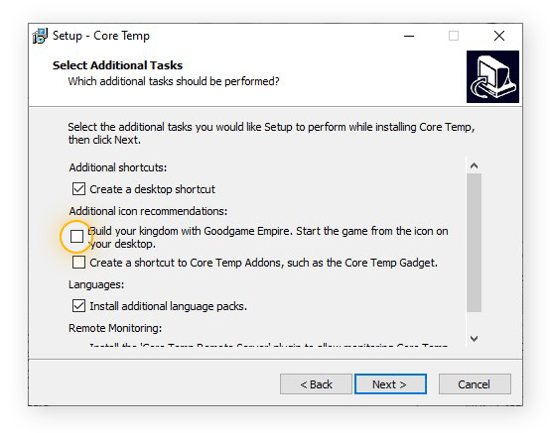 Installing Core Temp will also open up a helpful .TXT document with detailed instructions on using the plan.
Installing Core Temp will also open up a helpful .TXT document with detailed instructions on using the plan. -
Open up Cadre Temp and focus on the bottom of the window, where information technology says "Cadre #0". Depending on how many CPU cores your reckoner has, your window may look slightly dissimilar than ours.
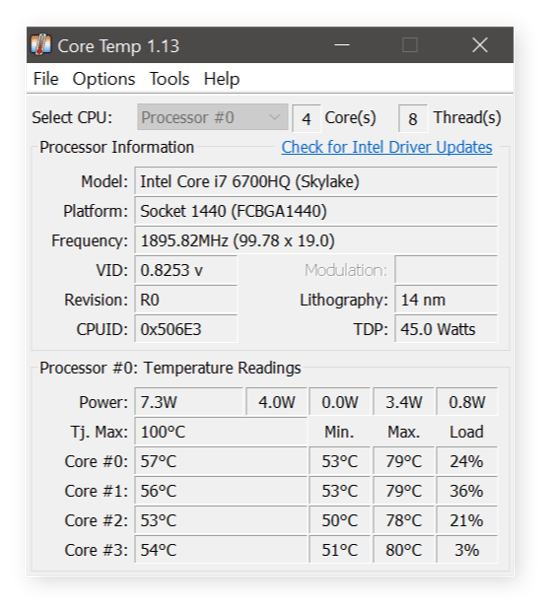 If you lot want to view your readings in Fahrenheit, you lot can find that option in Options > Settings > Display.
If you lot want to view your readings in Fahrenheit, you lot can find that option in Options > Settings > Display. -
Moving from left to right, Cadre Temp tells yous iv important things about the temperature of each CPU cadre:
-
The electric current temperature
-
The minimum recorded temperature
-
The maximum recorded temperature
-
The current workload percentage
-
Check your CPU temperature in your UEFI/BIOS
The BIOS (Bones Input/Output System) is a behind-the-scenes expanse of your operating system that contains your firmware settings. In newer computers running Windows 10, the BIOS has been replaced with an updated counterpart known every bit UEFI (Unified Extensible Firmware Interface). Functionally, UEFI and BIOS are the same.
If you have an older auto, yous can admission your BIOS past pressing a specific key or key combination every bit your computer boots. Commonly, this is F12, F2, Esc, or Delete — your computer volition tell you during its bootup procedure what to press to open BIOS (or Setup).
On newer computers, yous can achieve your UEFI past opening the Windows menu in the lower-left corner of your screen, clicking Power, holding the Shift key, and selecting Restart. Your computer will reset and display a serial of menus: choose Troubleshoot > Advanced options > UEFI Firmware Settings, and so click Restart.
Checking your temps in the UEFI/BIOS is inconvenient for a couple of reasons. For one, your computer needs to restart, which means that you'll need to stop whatsoever else you're doing. Also, yous tin can't monitor your temps over fourth dimension in the UEFI/BIOS — you'll run across simply a one-time snapshot. That's why we recommend using a software pick while Windows is up and running.
How to monitor your CPU temperature over time
Checking your temps once is nice, but it'southward not going to provide you with much useful information. To get a fuller motion-picture show of your reckoner'southward health, yous'll want to monitor your CPU temperature over time.
This is especially important when performing long intensive tasks, such every bit video rendering or playing resource-hungry video games. Straight sunlight can also oestrus things up quickly, then exist sure to use a laptop temperature monitor when computing outdoors.
Since UEFI/BIOS can't function as a long-term PC temperature monitor, y'all'll demand a software solution. Again, nosotros'll apply Core Temp here as our Windows ten temperature monitor. Here'south how to prepare that up:
-
With Cadre Temp installed, click the pocket-size upward-pointing arrow in your taskbar to view your groundwork applications.
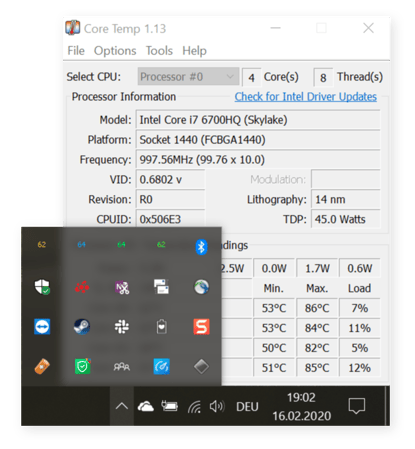
-
The multicolored numbers at the meridian represent the current temperatures of your CPU cores. Yous tin check them here anytime you like, or click and elevate them to the taskbar to display them permanently.
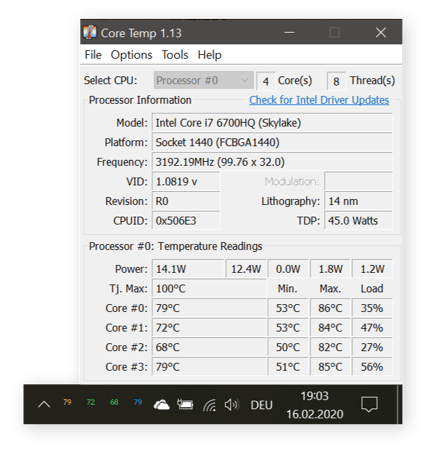
-
To conserve infinite in your taskbar, you lot can elect to view merely the highest temperature at whatsoever given time. In Core Temp, head to Options > Settings > Notification Area, and then select Highest temperature per processor.
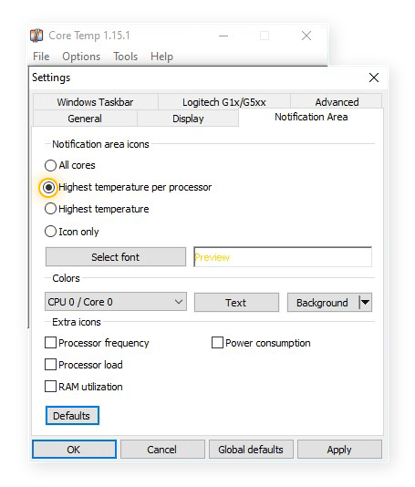
Monitoring CPU temps in fullscreen way
You can't view your taskbar while fullscreening a game or movie, so nosotros'll need another solution if y'all'd like to continue an heart on your CPU temps during those activities. Bundled with the GPU overclocking utility MSI Afterburner is a slap-up little tool called RivaTuner, which volition let you display your CPU temps even while in fullscreen style.
You lot can also download RivaTuner on its own, but its programmer recommends that you run it together with MSI Afterburning for optimal performance. Hither'southward how to get it set up for fullscreen temperature monitoring:
-
After installing MSI Afterburner and RivaTuner, open up your background apps and click on the MSI Afterburner icon.
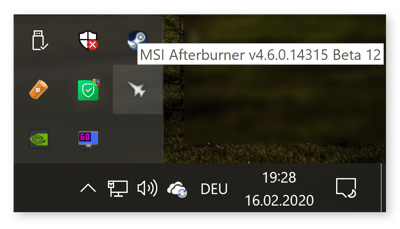
-
Open the Settings and navigate to the Monitoring tab. Scroll downward and click CPU Temperature, then select the box for Prove in On-Screen Display.
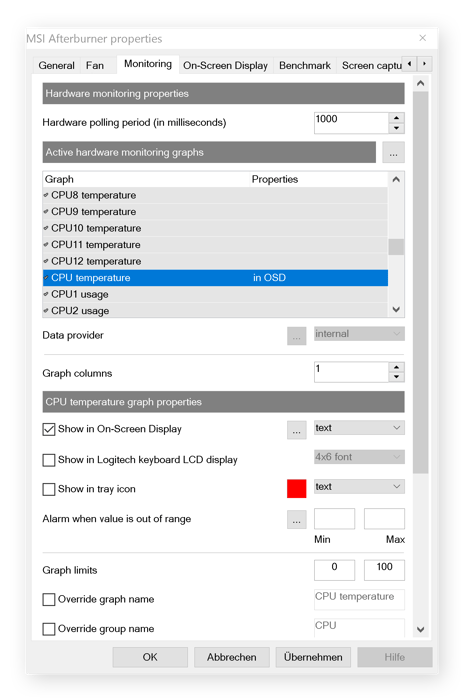
-
Switch to the On-Screen Display tab and cull a hotkey configuration that y'all'll use to bring up your monitoring information. Someday you're in a fullscreen app, y'all can input your hotkeys to view your CPU temps.

What temperature should my CPU be?
Under typical circumstances, your CPU temp should remain between 40 and 65 degrees Celsius (or 104°F and 149°F). Your PC temperature may vary depending on your computer, CPU, and level of action, but anything within that window is normal and fine.
The normal CPU temp for your PC may vary depending on what you accept. For example, in a high-end, custom-built gaming PC with loads of expensive cooling equipment, temps of around l degrees Celsius (122°F) are not unusual. A powerful laptop, on the other mitt, might run at around 75 degrees Celsius (167°F), due to the limited infinite and cooling options.
When pushed nearly its limits, CPU temps tin can exceed eighty degrees Celsius (176°F). This isn't necessarily a crusade for alert, only don't let your reckoner remain at this oestrus level for long if you can avoid information technology, or you may experience functioning slowdowns.
Extended gaming sessions can likewise stress your graphics processing unit of measurement (GPU), so be aware that yous'll want to bank check and monitor your GPU temperature as well. This is specially of import if y'all've installed a high-end GPU designed for optimal gaming performance, since you'll likely be playing for hours at a time.
Sustained heat of over xc degrees Celsius (194°F) can crusade physical harm to your CPU, and so if you're seeing numbers like that for several sequent days, take steps to reduce the strain you're putting on your CPU. Numbers like this mean your CPU temp is too high.
Does CPU temperature impact performance?
Equally mentioned above, your computer can and will likely slow down if yous run information technology at high temperatures for sustained periods of time. At temperatures of ninety degrees Celsius (194°F) and above, your CPU may self-throttle, or regulate its own activity, in lodge to reduce the generation of additional estrus. In some cases, this can cause your iii GHz processor to throttle down to 800 MHz, for example, significantly reducing your operation. Some CPUs may shut down entirely to avert permanent harm from the high temperatures.
That's why it's crucial to monitor your CPU temps on a daily footing. Information technology'southward specially useful if you're planning to heave your calculator'southward performance via a CPU overclock. Overclocking is a popular technique to coax more power out of a gaming computer, merely information technology comes at the cost of increased temperatures. We'd all dear to run GTA Five at optimal graphical fidelity and frame rates, simply hardware has its limits.
Without sufficient cooling measures, you might see trouble if y'all push things too far. That'south why and so many custom-congenital gaming PCs use water cooling to increment operation. Since temperatures tin straight impact performance, you'll need to control your computer's rut output in order to speed upwards your computer.
Also, many types of malware place a heavy strain on your CPU, leading to an increase in temperature. Always utilise a reliable antivirus tool like AVG AntiVirus FREE to detect, block, and remove malware from your computer.
How to lower your CPU temperature
Equally a showtime step to lowering your CPU temp, improve the airflow to your computer. Place your laptop on a shine, firm surface like a tabular array or desk (not your bed!). The same goes for your desktop PC: go on it off the carpet. Also consider using a laptop cooling stand to supply your laptop with a steady stream of air. Almost important, air cooling relies on the air outside your computer being libation than the air inside it, and then minimize your computer utilise if your environment is likewise hot.
With a flake of elbow grease and a conscientious mitt, you tin can perform some simple computer surgery to bring your one-time PC back into tip-top shape and keep its temperatures downwardly. Apply a can of compressed air to clear any dust from the fans and vents, and replace your CPU's thermal paste. Thermal paste makes your CPU's heatsink more efficient, which results in lower temperatures.
All computers get slower over time, and a lot of that slowdown is due to an accumulation of unneeded data. Slim down your hd by removing bloatware and getting rid of any unwanted apps, then defrag your bulldoze to requite information technology a fresh first.
Finish overheating and boost performance at present
An efficient calculator is always going to run smoother, faster, and cooler than one that'south alluvion with junk files and useless software. AVG TuneUp eliminates excess baggage to free your CPU up for the tasks that actually thing — keeping temperatures down and performance up, all without any changes to your hardware.
Source: https://www.avg.com/en/signal/check-cpu-temperature
0 Response to "V2015 Visual Studio How to Read Cpu Temperature"
Post a Comment